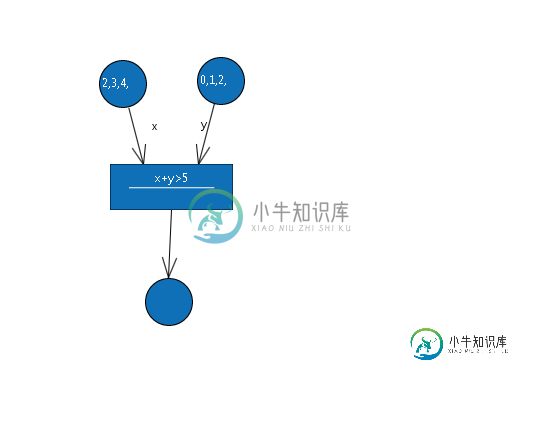递归回溯
我正在开发高级培养皿网络编辑器/模拟器。首先,这里有一些词汇
圆圈=位置
矩形=过渡
就地整数 = 标记
过渡状态=防护
我被困在通过过渡的守卫。守卫是一个条件,如果你想执行转换,这需要是真的。我知道我应该以某种方式使用回溯,但我不知道在程序开始之前进入过渡的位置数,所以我不能使用循环,因为我不知道我需要多少个循环。

所以,我想从第一位获取第一个令牌,从第二位获取第一令牌,然后尝试通过守卫,如果通过,则保存令牌,并打破循环,如果为假,继续使用第二位的第二令牌..等等…我最终使用第一位的最后一个令牌(4)和第二位最后一个符号(2)通过守卫。
我会知道如何编写代码,如果我有恒定数量的地方进入过渡,它会像这样
for token in place 1
for token in place 2
try pass guard
if (passed)
save tokens
break;
但正如我之前所说,我没有恒定数量的地方进入过渡,所以我不能使用这种方法。所以,基本上,我需要尝试令牌的组合,并尝试通过保护-直到我通过保护,或者直到我尝试了所有组合。你有什么想法吗?伪代码就足够了。顺便说一句,我使用这些数据结构
位置列表 - 普通 java 列表,列表位置 = new ArrayList();
每个地方都有自己的令牌列表,list tokens=new ArrayList();
///编辑:保护具有以下格式:
op1 rel op2,其中op1是变量,而op2是常数或变量,rel是关系(
----编辑:
所以我尝试实现Rushil算法,但它很有缺陷,所以我发布了SSCCE,所以你可以尝试一下,也许会有所帮助。
首先,创建 Place 类:
public class Place {
public List<Integer> tokens ;
//constructor
public Place() {
this.tokens = new ArrayList<Integer>();
}
}
然后测试类:
public class TestyParmutace {
/**
* @param args the command line arguments
*/
public static void main(String[] args) {
// TODO code application logic here
List<Place> places = new ArrayList<Place>();
Place place1 = new Place();
place1.tokens.add(1);
place1.tokens.add(2);
place1.tokens.add(3);
places.add(place1); //add place to the list
Place place2 = new Place();
place2.tokens.add(3);
place2.tokens.add(4);
place2.tokens.add(5);
places.add(place2); //add place to the list
Place place3 = new Place();
place3.tokens.add(6);
place3.tokens.add(7);
place3.tokens.add(8);
places.add(place3); //add place to the list
//so we have
//P1 = {1,2,3}
//P2 = {3,4,5}
//P3 = {6,7,8}
List<Integer> tokens = new ArrayList<Integer>();
Func(places,0,tokens);
}
/**
*
* @param places list of places
* @param index index of current place
* @param tokens list of tokens
* @return true if we passed guard, false if we did not
*/
public static boolean Func( List<Place> places, int index, List<Integer> tokens)
{
if (index >= places.size())
{
// if control reaches here, it means that we've recursed through a particular combination
// ( consisting of exactly 1 token from each place ), and there are no more "places" left
String outputTokens = "";
for (int i = 0; i< tokens.size(); i++) {
outputTokens+= tokens.get(i) +",";
}
System.out.println("Tokens: "+outputTokens);
if (tokens.get(0) == 4 && tokens.get(1) == 5 && tokens.get(2) == 10) {
System.out.println("we passed the guard with 3,5,8");
return true;
}
else {
tokens.remove(tokens.get(tokens.size()-1));
return false;
}
}
Place p = places.get(index);
for (int i = 0; i< p.tokens.size(); i++)
{
tokens.add(p.tokens.get(i));
//System.out.println("Pridali sme token:" + p.tokens.get(i));
if ( Func( places, index+1, tokens ) ) return true;
}
if (tokens.size()>0)
tokens.remove(tokens.get(tokens.size()-1));
return false;
}
}
下面是这段代码的输出:
Tokens: 1,3,6,
Tokens: 1,3,7,
Tokens: 1,3,8,
Tokens: 3,4,6,
Tokens: 3,4,7,
Tokens: 3,4,8,
Tokens: 4,5,6,
Tokens: 4,5,7,
Tokens: 4,5,8,
Tokens: 2,3,6,
Tokens: 2,3,7,
Tokens: 2,3,8,
Tokens: 3,4,6,
Tokens: 3,4,7,
Tokens: 3,4,8,
Tokens: 4,5,6,
Tokens: 4,5,7,
Tokens: 4,5,8,
Tokens: 3,3,6,
Tokens: 3,3,7,
Tokens: 3,3,8,
Tokens: 3,4,6,
Tokens: 3,4,7,
Tokens: 3,4,8,
Tokens: 4,5,6,
Tokens: 4,5,7,
Tokens: 4,5,8,
所以,你看,有些组合是正确的,比如1,3,6和1,3,7...但是4,5,8是完全没有意义的,因为4根本就不在首位...也有完全缺失的组合..比如2,4,6等等...有人知道为什么会这样吗?
编辑:现在它运行良好。
共有3个答案
那么像这样的东西呢:
method getPassed(places, tokens):
if places are empty:
try pass guard
if (passed)
save tokens
return true
else return false
else:
for token in places[0]:
if getPassed(places[1:].clone(), tokens.clone().append(token)):
break
从调用 getPassed(places, []) 开始,其中 places 是一个地点列表,[] 是空列表。请注意,您需要始终复制列表,以免最终弄乱它们。
最后,不需要配对。如果您保留在开始时传递到算法中的原始位置列表,您就知道标记[i]是为原始位置[i]选择的。
但是如果你愿意,你可以保留tokensPlaces对来代替token,比如:
method getPassed(places, tokenPlacePairs):
if places are empty:
try pass guard
if (passed)
save tokens
return true
else return false
else:
for token in places[0]:
if getPassed(places[1:].clone(), tokens.clone().append((token, places[0]))):
break
编辑:仍然有些混乱,希望这能弄清楚。我正在尝试递归生成for循环。所以如果地方只有2个元素,你会得到你建议的:
for token in place 1
for token in place 2
try pass guard
if (passed)
save tokens
break;
因此,它所做的是,它从列表中获取第一位,并创建“for token in place 1”循环。然后,它从位置列表中剪切该位置,并将当前令牌添加到令牌列表中。此递归调用现在执行“for token in place 2”循环。等等。每个递归调用,我们将位置数减少 1 个,并创建 1 个 for 循环。因此,在地点列表为空之后,我们有n个嵌套循环,其中n是地点的数量,据我所知,这就是你正在寻找的。
您可以通过以下方式启动该方法:
originalPlaces = places.clone()
getPassed(places, [])
这样,您可以保持原始位置不变,并且当您到达递归中的基本情况时,即当您尝试确定传递保护时,您可以将令牌[i]分配给原始位置[i]。因此,您并不真正需要这些对。
您可以自己进行循环管理。我的意思是:你需要一个类来描述每个地方的迭代状态。让我们称之为state_of_place。它由两个值组成:一个current_index和一个max_index。
接下来,您将有一个名为iteration_admin的类,它由一个state_of_place数组和一个类似iteration _in_progress的布尔值组成。创建时,布尔值设置为TRUE。您将创建尽可能多的state_of_place对象。Current_ index将为0,max_。
iteration_admin类需要一个方法来表示循环变量的增量。让我们称之为increment()。如果current_index仍然低于max_index,该方法将递增具有最高索引的state_of_place元素的current_index。如果current_index等于max_index,则当前索引被设置为0,并且具有下一个更低索引的state_of_place的当前索引需要递增。如果那个已经达到它的max_index,它将被设置为0,下一个更低的将递增,等等。当然,唯一的例外是state_of_place[0]。如果元素current_index将超过其max_index,则布尔iteration_in_progress将被设置为FALSE。这意味着所有的令牌组合都已被使用。
现在,你测试警卫的代码是
- 初始化类型为 iteration_admin 的对象
- 而iteration_admin.iteration_in_progress is true
- 通过使用state_of_place元素中的current_index值为 pass() 方法生成参数列表
- 调用传递()
- 如果未传递,则调用 iteration_admin.increment() 方法
- 结束而
编辑:试图用伪代码表达想法。我担心它看起来更像是Java和PL/SQL的混合,而不是抽象的伪代码。尽管如此,它应该比我的文字描述更清楚一些。
// iteration state for one place
class state_of_a_place
{
integer current_index;
integer max_index;
}
// iteration administration for one transition
class iteration_admin
{
boolean iteration_in_progress
state_of_a_place[] state_of_places
procedure increment
{
// move index through tokens
FOR i IN state_of_places.count-1 .. 0 LOOP
IF state_of_places[i].current_index < state_of_places[i].max_index THEN
state_of_places[i].current_index += 1
return
ELSE
state_of_places[i].current_index = 0
IF i = 0 THEN
iteration_in_progress = FALSE
END IF
END IF
END FOR
}
}
handle_transition (list_of_places)
{
// initialize an object of type iteration_admin
iteration_admin ia
ia.iteration_in_progress = TRUE
FOR i IN 0..list_of_places.count LOOP
ia.state_of_places[i].current_index = 0
ia.state_of_places[i].max_index = list_of_places[i].number_of_tokens
END FOR
WHILE ia.iteration_in_progress LOOP
// build the argument list for the pass() method
token[] arguments
FOR i IN 0..list_of_places.count LOOP
arguments[i] = list_of_places[i].token[ia.state_of_places[i].current_index]
END FOR
// try to pass the guard
call pass(arguments)
IF (passed)
// do whatever you need to do here
ELSE
ia.increment()
END IF
END WHILE
}
递归方法将使其变得容易:
boolean Func( ListOfPlaces places, int index ) // index points to the current "place"
{
If index >= NumberOfTokens (if index points to a place, which doesn't exist)
{
// if control reaches here, it means that we've recursed through a particular combination ( consisting of exactly 1 token from each place ), and there are no more "places" left. You have all the tokens you need, in your stack.
try pass guard; if passed, save tokens and return true
else, remove token last added to the stack & and return false
}
place p = places[index]
foreach token in p
{
add token to your stack
if ( Func( places, index+1 ) ) return true
}
remove last token added to the stack
return false
}
最初调用索引 = 0 的函数。
希望这有所帮助。:-)
-
我正在创建一个递归导航迷宫的程序。代码: 然而,每当我到达死胡同时,它都不会回溯。当我调试时,它表明当程序从递归或“回溯”返回时,我的起始值专注于停留在我的死胡同空间。 例如: 9是我的出发点。2是我的退出。4是我的道路。1 表示墙壁。当我到达一个死胡同时(在本例中为第 7 行,第 2 列)。我的立场是等于整个程序其余部分的死胡同空间。这是为什么呢?
-
我的问题是,当一个9不能正确添加时,该方法会中断。不知何故,我不知道如何让它回到前一点,并向上数,这将创建一个新的“路径”,所以我想如果我做对了,一切都应该很好。我仍然在使用递归:-/ 正如我所知,我认为Sudokurecrect()做了它应该做的事情。编辑:您可以忽略布尔测试。我知道我不使用它,我试着想一些东西,但显然我不知道如何使用它。 输出为 在那之后,不管检查哪个变体。所以问题是一样的。
-
我对编码还是很陌生的,我正在尝试一些稍微困难的主题,例如修改数独递归回溯程序的解决方案。最初的解决方案是针对大小为3x3的数独,我希望我的解决方案可以与正常大小的数独(9x9)一起使用。3x3解决方案在这里找到。 我觉得我对算法非常了解:对于网格中的每个列表(包含该单元格的可能值),在每一步尝试每个数字,确保电路板仍然有效,移动到下一个列表,分配一个可能的数字直到其有效,等等。如果当前电路板不正确
-
我不得不使用全局变量found来指示在哪里找到了一个和。返回语句始终未定义。 此外,如果在下面的if语句中使用return语句,代码将无法正常工作。 这不是问题的最佳解决方案,但这是我得到的工作版本。 返回语句之间的****,删除时代码工作,否则我要么得到false或未定义。我不明白这部分!为什么删除返回就能解决问题,我认为每个递归调用都必须用返回语句进行。 问题可能是由于多次呼叫造成的吗?我是不
-
我试图用C++中的回溯和递归来解决C++中的幻方问题。特别适用于4x4数组。 4x4幻方解的一个例子如下,其中每行、每列和对角线加34: 我所做的更改是:用户输入一些值,这些值将启动算法。 我的算法是这样的: 在这里你可以更好地欣赏图像。 我有一个概念,算法应该如何工作,以解决幻方的问题,回溯和递归,但我有问题。 其中之一是: 成就并没有让我的算法“忽略”用户已经输入的值。 我在C++中的代码在G
-
我的任务是用回溯和递归的方法解决一个迷宫。这更多的是一个关于这个概念的概念问题。 回溯电话是如何接通的?从我所看到的所有示例来看,似乎递归总是在回溯步骤之前立即调用,所以回溯是无法实现的。谁能给我解释一下回溯步骤是怎么达到的?

